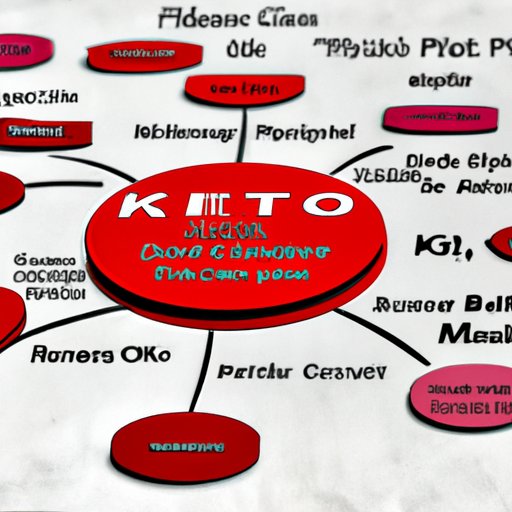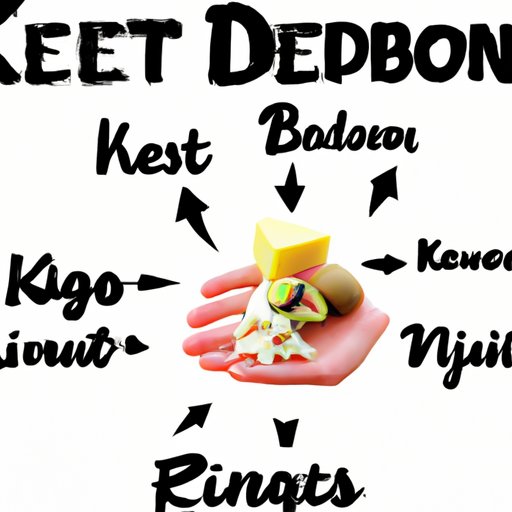Introduction
The keto diet plan, also known as the ketogenic diet or low-carb diet, is a high-fat, low-carbohydrate diet that has become increasingly popular over the past few years. The goal of the keto diet plan is to put your body into a state of ketosis, which is when your body starts burning fat for energy instead of carbohydrates. While there are many different versions of the keto diet plan, the main idea behind it is to drastically reduce your intake of carbohydrates and replace them with healthy fats.

Definition and Overview of the Keto Diet Plan
The keto diet plan is a form of nutritional therapy designed to induce a state of ketosis in the body. Ketosis occurs when the body has exhausted its glucose reserves and switches to using stored fat as its primary source of fuel. This process results in the production of molecules called ketones, which are then used by the body as an energy source. The keto diet plan is based on the principle of consuming fewer carbohydrates and more fats in order to achieve a state of ketosis.

Benefits of Following a Keto Diet Plan
There are numerous potential benefits associated with following a keto diet plan. Studies have found that the keto diet plan may help improve blood sugar levels, reduce inflammation, and improve cholesterol levels. It can also aid in weight loss, as the body will burn fat for energy rather than carbs, leading to a decrease in overall calorie intake. Additionally, some research suggests that following a keto diet plan may help reduce the risk of certain types of cancer.
How to Get Started with a Keto Diet Plan
Starting a keto diet plan can seem overwhelming at first, but it doesn’t have to be. Here are some steps to help you get started:
Deciding if a Keto Diet is Right for You
Before starting any diet, it’s important to consult with a healthcare professional to make sure it’s right for you. The keto diet plan is not suitable for everyone, so it’s important to talk to your doctor before beginning.
Calculating Your Macros
Once you’ve decided that a keto diet plan is right for you, the next step is to figure out how much of each macro (fats, proteins, and carbohydrates) you need to consume in order to reach your goals. Many websites have calculators that can help you determine your macros based on your age, gender, activity level, and other factors.
Finding Recipes and Meal Plans
After calculating your macros, you’ll need to find recipes and meal plans that fit within your dietary goals. Fortunately, there are plenty of online resources available to help you find delicious recipes and meal plans that are tailored to the keto diet plan.
Common Foods Included in a Keto Diet Plan
When following a keto diet plan, it’s important to focus on eating whole, unprocessed foods. Here are some common foods you’ll want to include in your diet:
High-Fat Foods
One of the most important components of the keto diet plan is eating high-fat foods. Some good sources of healthy fats include avocados, olive oil, nuts, seeds, and fatty fish such as salmon and mackerel.
Low-Carbohydrate Foods
In addition to high-fat foods, you’ll also want to focus on eating low-carbohydrate foods. Examples of low-carb foods include non-starchy vegetables such as kale, spinach, and broccoli, as well as eggs, cheese, and plain Greek yogurt.
Protein Sources
Finally, it’s important to include protein in your diet. Good sources of protein include lean meats such as chicken and turkey, as well as legumes, tofu, and tempeh.

Sample Keto Diet Plan for Beginners
If you’re just getting started with a keto diet plan, here is a sample meal plan that you can try:
An Example Meal Plan
Breakfast: Two eggs cooked in olive oil, one slice of bacon, one cup of spinach
Lunch: Greek salad with feta cheese, olives, and grilled chicken
Snack: Celery sticks with almond butter
Dinner: Baked salmon with roasted vegetables
Bedtime Snack: Full-fat Greek yogurt with berries
Guidelines for Eating Out
When eating out, look for meals that are high in fat and low in carbohydrates. Choose items like salads with grilled chicken, steak with roasted vegetables, or burgers without the bun. Avoid items like pasta, rice, and breaded meats.

Tips for Sticking to a Keto Diet Plan
Following a keto diet plan requires dedication and commitment. Here are some tips to help you stick to the plan:
Tracking Your Progress
It’s important to track your progress when following a keto diet plan. Keeping a food diary can help you stay accountable and motivated. Additionally, tracking your progress can help you identify areas where you may need to make adjustments.
Avoiding Temptation
When following a keto diet plan, it’s important to avoid temptation. Try to avoid situations that could lead to overeating, such as social gatherings or buffets. Additionally, it’s important to have healthy snacks on hand to help you stay on track.
Understanding the Difference Between a Keto Diet and Other Low-Carb Diets
It’s important to understand the difference between a keto diet and other low-carb diets. While both diets involve limiting carbohydrate intake, the keto diet is much stricter and requires much more discipline. It’s important to do your research and understand the differences before starting a keto diet plan.
Potential Risks Associated with Following a Keto Diet Plan
While there are many potential benefits associated with following a keto diet plan, there are also some potential risks. It’s important to be aware of these risks before starting a keto diet plan:
Possible Side Effects
When first starting a keto diet plan, it’s common to experience side effects such as fatigue, nausea, headaches, and constipation. These side effects typically subside after a few days as your body adjusts to the new diet.
Potential Health Risks
Long-term use of a keto diet plan has been linked to an increased risk of kidney stones, kidney damage, and heart disease. Additionally, people with diabetes should be especially careful when following a keto diet plan, as it can cause dangerously low blood sugar levels. It’s important to talk to your doctor before starting a keto diet plan.
Conclusion
The keto diet plan is a high-fat, low-carbohydrate diet that has been shown to offer numerous health benefits, including improved blood sugar levels, reduced inflammation, and improved cholesterol levels. It can also help with weight loss and may even reduce the risk of certain types of cancer. Before starting a keto diet plan, it’s important to consult with a healthcare professional to make sure it’s right for you. Additionally, it’s important to understand the risks associated with the diet, such as possible side effects and long-term health risks. With the right approach and attitude, the keto diet plan can be an effective way to achieve your health and fitness goals.
(Note: Is this article not meeting your expectations? Do you have knowledge or insights to share? Unlock new opportunities and expand your reach by joining our authors team. Click Registration to join us and share your expertise with our readers.)
